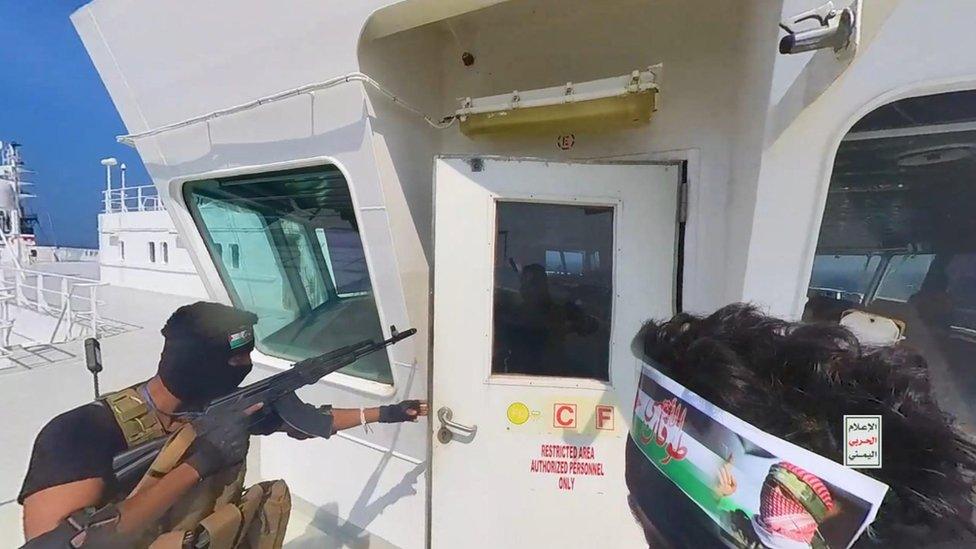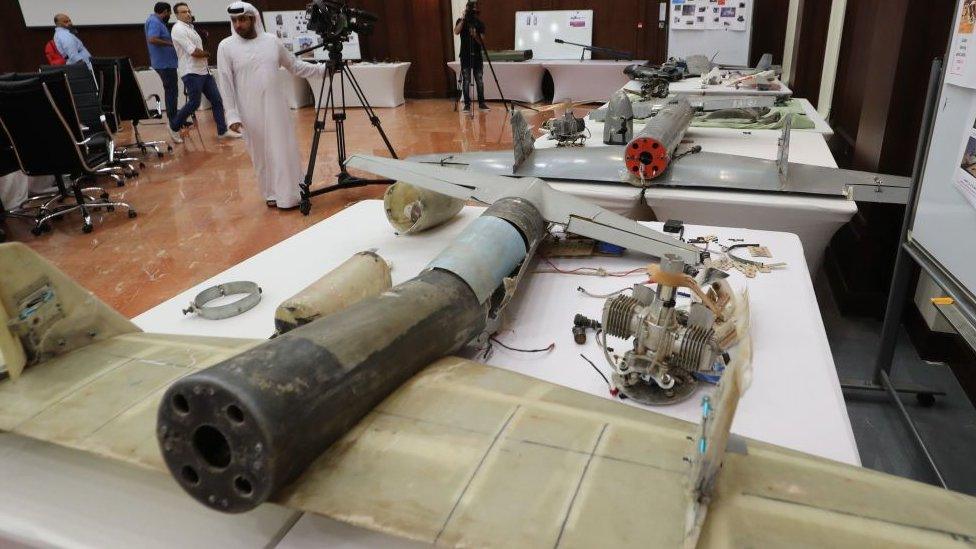Who are the Houthis and why is the US targeting them?
- Published

Houthi supporters in Sanaa protesting against Israel's blockade of aid deliveries to Gaza
The start of the Israel-Hamas war in October 2023 brought a new kind of conflict to prominence, with Iran-backed Houthi rebels attacking commercial ships in the Red Sea and Gulf of Aden.
The US launched several attacks in response. The latest, in mid-March, shook the new Trump presidency after it emerged that a journalist had been invited to a messaging group in which his most senior officials, including the vice-president, were discussing details of the attacks about to be launched.
Why have the Houthis attacked Red Sea ships?
Initially, the Houthis started firing drones and missiles towards Israel. Most were intercepted.
On 19 November 2023, the Houthis hijacked a commercial ship in the Red Sea.
They have since launched dozens of missile and drone attacks on commercial ships.
They have sunk two vessels, seized a third and killed four crew members.
US-led naval forces have thwarted many attacks.
The Houthis initially said they were attacking ships connected with Israel, or heading to or from there. However, many of the vessels have no connection with Israel.
In response to US and UK air strikes on their positions, the Houthis began targeting ships tied to owners or operators in the UK or US.
The attacks forced even major shipping companies to stop using the Red Sea - through which almost 15% of global seaborne trade usually passes - and to take a much longer route around southern Africa instead.
Why are the US, often with UK help, bombing Yemen?
The US and UK started carrying out air strikes on Houthi targets in Yemen in January 2024.
President Joe Biden said they were in "direct response" to the attacks on Red Sea ships, which "jeopardised trade, and threatened freedom of navigation".
His successor, though, blamed him for not doing enough and in March 2025 Donald Trump authorised a wave of air strikes on Houthi targets.
"Funded by Iran, the Houthi thugs have fired missiles at US aircraft, and targeted our troops and allies," Trump said, adding that their "piracy, violence, and terrorism" had cost "billions" and put lives at risk.
Trump said that it had been more than a year since a US-flagged ship had sailed safely through the Suez Canal - which the Red Sea leads to - and four months since a US warship had been through the body of water between east Africa and the Arabian peninsula.

Houthi fighters hijacked a British-owned and Japanese-operated ship in the Red Sea on 19 November
The Suez Canal is the quickest sea route between Asia and Europe, and is particularly important in the transportation of oil and liquefied natural gas (LNG).
Trump urged Iran to cease its support for the Houthis, warning that Washington would hold Tehran "fully accountable and, we won't be nice about it".
Sean Parnell, the Pentagon's spokesman, explicitly linked the strikes to Iran and the Trump administration's desire to deviate from Joe Biden's policies towards the country.
"Under the previous administration, America's enemies were emboldened and billions in frozen funds were unlocked for Iran," he said. "With President Trump... an era of peace through strength is back."
Who are the Houthis?
The Houthis are an armed political and religious group which champions Yemen's Shia Muslim minority, the Zaidis.
They declare themselves to be part of the Iranian-led "axis of resistance" against Israel, the US and the wider West - along with armed groups such as Hamas and Lebanon's Hezbollah movement.
Formally known as the Ansar Allah (Partisans of God), the group emerged in the 1990s and takes its name from the movement's late founder, Hussein al-Houthi. The current leader is his brother, Abdul Malik al-Houthi.
In the early 2000s, the Houthis fought a series of rebellions against Yemen's long-time authoritarian president, Ali Abdullah Saleh. They wanted greater autonomy for the group's homeland in the north of Yemen.
During the 2011 Arab Spring, a popular uprising forced President Saleh to hand over power to his deputy, Abdrabbuh Mansour Hadi.
President Hadi's government was overwhelmed with problems. The Houthis seized control of the northern province of Saada before taking the Yemeni capital, Sanaa, after forming an unlikely alliance with Saleh and security forces still loyal to him.
In 2015, the rebels seized large parts of western Yemen and forced Mr Hadi to flee abroad.
Neighbouring Saudi Arabia feared the Houthis would take over Yemen and make it a satellite of its rival, Iran.
It formed a coalition of Arab countries that intervened in the war. But years of air strikes and ground fighting have not dislodged the Houthis from most of the territory they seized.
Saudi Arabia has been trying to make a peace deal with the Houthis.
The war has killed more than 160,000 people, according to the Armed Conflict Location & Event Data Project (ACLED). More than four million people have been displaced.
Who backs the Houthis and how do they get their weapons?
The US says Iran enabled the Houthis to target ships, and President Biden sent a "private message" to Tehran urging it to stop. Iran has denied involvement.
Saudi Arabia and the US say Iran has smuggled weapons - including drones, and cruise and ballistic missiles - to the Houthis during Yemen's civil war in violation of a UN arms embargo.
It says such missiles and drones have been used in attacks on Saudi Arabia, as well as its ally, the United Arab Emirates.

Wreckage of a drone launched from Yemen at the UAE capital, Abu Dhabi, in 2022
Iran denies supplying weapons to the Houthis and says it only supports them politically.
"The Houthis could not operate at this level without Iranian arms, training and intelligence," says Dr Elisabeth Kendall, a Middle East specialist at Cambridge University.
However, she adds: "It is unclear that Iran has direct command and control over the Houthis."
According to the Italian Institute of International Political Studies, Iran has helped the Houthis build factories to make drones in Yemen, external.
The Houthis have also received military advice and support from the Lebanese Islamist group Hezbollah, external, the US-based Combating Terrorism Center at West Point Military Academy says.
How much of Yemen do the Houthis control?
Yemen has been devastated by a civil war that escalated 10 years ago, when the Houthis seized control of the country's north-west from the internationally-recognised government and a Saudi-led coalition supported by the US intervened in an effort to restore its rule.
The fighting has reportedly left more than 150,000 people dead and triggered a humanitarian disaster, with 4.8 million people displaced and 19.5 million - half of the population - in need of some form of aid.
The Houthis control Sanaa and the north-west of Yemen, including the Red Sea coastline.
Most of Yemen's population lives in these areas, and the Houthis run a de facto government which collects taxes and prints money.